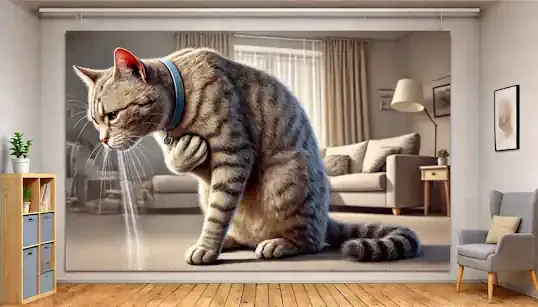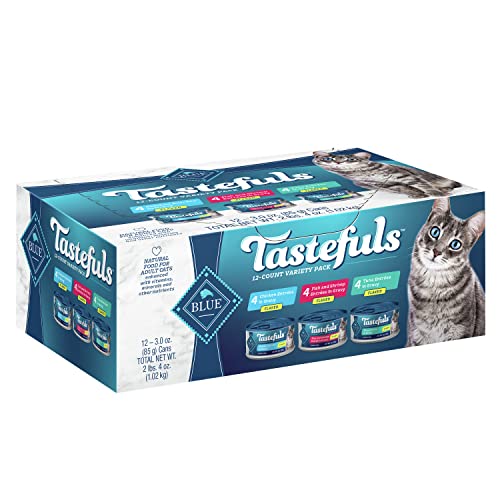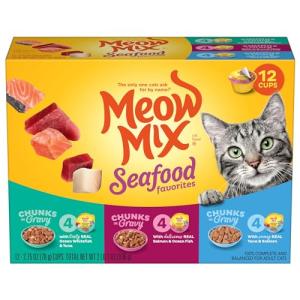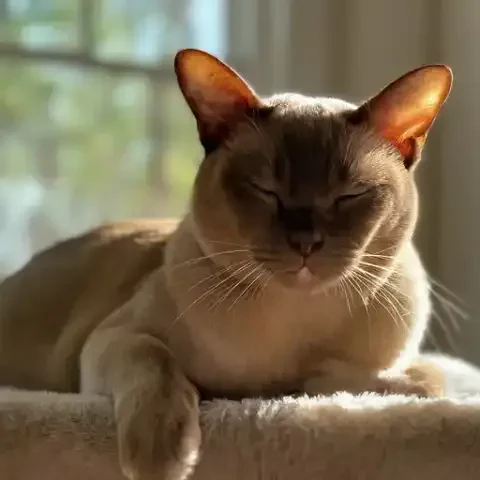That unsettling sound – a hacking, wheezing, or maybe even a dry, rasping noise – has suddenly broken the peaceful quiet of your home. Your feline friend, usually the picture of graceful composure, is now caught in a bout of coughing. It's a moment that can instantly trigger alarm in any cat owner. Hearing your cat cough can be disconcerting, even frightening, and your first instinct is likely to understand: why is this happening, and what can I do to help them feel better?
While a cough in humans might often be dismissed as a minor nuisance, perhaps a fleeting annoyance associated with a common cold, in cats, coughing can be a significant symptom. It’s not typically just a passing irritation; rather, it's often a signal from their body that something underlying needs attention. Coughing in cats can be an indicator of a surprisingly wide range of health issues, some relatively minor and easily managed, but others potentially serious and requiring prompt veterinary intervention. Deciphering the cause of your cat's cough is the critical first step in ensuring they receive the appropriate care and can return to their usual happy, healthy selves. This article is designed to be your comprehensive guide to understanding feline coughs. We will navigate the often-confusing world of potential causes, from simple infections to more complex conditions, and explore the diagnostic journeys and treatment pathways available to your feline companion. By arming you with knowledge, we aim to empower you to be a proactive advocate for your cat's respiratory health, ensuring they can breathe easily and comfortably once again.
Before we delve into the myriad of causes behind feline coughs, it’s crucial to first establish a clear understanding of what a cough actually is in a cat, and how to differentiate it from other similar-sounding behaviors. Sometimes, what sounds like a cough to a worried owner might be something else entirely. So, what are the hallmarks of a true feline cough? Typically, a cat cough is described as a hacking sound, often dry, or sometimes producing a moist or wet sound. It's an expulsive effort, meaning the cat is actively trying to force something out of their airways. Visually, you might observe your cat extending their neck, often crouching low to the ground, and making retching or gagging motions. This posture is part of the physical effort involved in coughing, as they engage their respiratory muscles to clear their airways. The key element is the expulsive nature of the act - it’s not just a sound, it's a physical attempt to expel something.
One of the most common sounds mistaken for a cough in cats is the retching or gagging associated with hairballs. It's vital to be able to differentiate between these two. A hairball episode is typically characterized by a gagging or retching sound before the cat actually produces a hairball, which is usually vomited up shortly after. Often, the sounds leading up to a hairball expulsion are more of a heaving or gagging, lacking the sharp, hacking quality of a true cough. Critically, a hairball event culminates in the production of a hairball – a clump of vomited hair. Hairball episodes are also often less frequent and can often be predicted, perhaps occurring more often after periods of intensive grooming. In contrast, a true cough often presents as a drier, hacking sound, and while it might produce mucus or phlegm in some cases, it typically does not result in the expulsion of a hairball. Coughing bouts can be repeated, and might be triggered by activity, occur more at night, or have other patterns not directly linked to recent grooming.
Sneezing is another behavior that can sometimes be confused with coughing. Sneezing, however, is a forceful expulsion of air primarily through the nose and mouth, aimed at clearing the nasal passages. It's usually triggered by irritants in the nose, such as dust, pollen, or upper respiratory infections, and it's often accompanied by nasal discharge. The sound of a sneeze is also distinct – more of a sharp "choo" or "atchoo" sound, originating from the nasal area. A cough, on the other hand, is primarily an effort from the lower airways and lungs, with the sound originating more from the chest and throat area.
Finally, it's important to be aware of "reverse sneezing," also known as paroxysmal respiration. This can be particularly confusing for owners because it can sound quite alarming and somewhat like coughing or choking. Reverse sneezing is characterized by a sudden, forceful inhalation of air through the nose. It often sounds like the cat is gasping, snorting inwards, or even choking. While it can look and sound dramatic, reverse sneezing is usually short-lived and is often caused by irritation in the nasal passages or back of the throat. The key differentiator from a cough is the direction of the effort – reverse sneezing is an inward gasp, while a cough is an outward expulsion. The body posture and sound quality are also distinct.
Once you've determined that your cat is indeed coughing, the next crucial step is to understand the potential underlying causes. The list of possibilities is surprisingly broad, ranging from common infections to more complex conditions. Respiratory infections are among the most frequent culprits behind coughing in cats. Viral infections, particularly Feline Herpesvirus and Feline Calicivirus, are common players in what’s often termed the "cat flu" complex. These viruses can cause a spectrum of respiratory symptoms, including a mild to moderate cough, alongside more typical “flu-like” signs such as sneezing, nasal discharge, and eye discharge. Bacterial infections often complicate viral infections, acting as secondary invaders. These bacterial infections can worsen the cough, and might be suspected if the discharge becomes thicker, colored (yellow or green), or if the cat's overall condition deteriorates despite initial improvement. Less commonly, but particularly relevant in certain geographic regions, fungal infections can cause coughing. Fungi like Blastomyces, Histoplasma, and Coccidioides are geographically specific and can cause serious respiratory illness, with coughing as a prominent symptom. These infections are often acquired through inhalation of fungal spores from the environment.
Feline asthma, also known as allergic or inflammatory airway disease, is a very common cause of chronic coughing in cats, particularly in younger to middle-aged animals. It’s helpful to think of feline asthma analogously to human asthma – it’s characterized by chronic inflammation of the airways, bronchoconstriction (narrowing of the airways), and excessive mucus production. The typical cough associated with feline asthma is often described as a dry, hacking cough, sometimes accompanied by wheezing. The cough can be episodic, flaring up periodically, or it can be a more chronic, ongoing issue. Asthma coughs may worsen with stress or exposure to allergens. Common triggers for feline asthma include airborne allergens like pollen, dust mites, mold spores, as well as irritants such as cigarette smoke, perfumes, and household cleaning products.
Coughing in cats can also be a sign of underlying heart disease. Specifically, congestive heart failure (CHF), where the heart is no longer effectively pumping blood, can lead to fluid buildup in the lungs, a condition known as pulmonary edema. This fluid accumulation in the lungs irritates the airways and triggers the cough reflex. A cough related to heart disease, or cardiogenic cough, is often described as a softer, moist cough compared to the dry cough of asthma. It might be accompanied by other concerning signs of heart failure, such as rapid breathing, labored breathing (difficulty getting enough air), lethargy, and exercise intolerance (becoming easily tired or short of breath with activity). It’s crucial to differentiate a heart-related cough as it signifies a serious underlying cardiac issue and requires prompt veterinary attention.
Parasitic infections can also manifest as coughing in cats. Lungworms are parasites that, as their name suggests, reside in the lungs and airways of cats. Various species of lungworms can infect cats, and infection typically occurs through the ingestion of infected snails, slugs, or sometimes rodents that have consumed infected snails or slugs. The presence of lungworms in the airways causes irritation and inflammation, leading to coughing. While heartworms are more commonly associated with dogs, cats can also be infected, although the disease presentation is often different. Heartworms (Dirofilaria immitis) are parasites that live in the heart and major blood vessels. In cats, heartworm infection can cause lung inflammation and coughing, although respiratory signs are often less prominent than in dogs, and other, more subtle symptoms might predominate. The cough associated with parasitic infections can be variable, often chronic, and may be accompanied by other signs such as weight loss, poor body condition, and sometimes wheezing.
Inhaled foreign bodies are another potential cause of sudden coughing in cats. Curious cats might inhale small objects, such as grass blades, plant material, or small toys, which can become lodged in their airways. This obstruction and irritation immediately trigger coughing. Coughing due to an inhaled foreign body is often characterized by a sudden onset, potentially accompanied by gagging, distress, and attempts to dislodge the object.
Beyond infections and internal diseases, environmental irritants can also provoke coughing in cats. Exposure to smoke, whether from cigarette smoke or wildfire smoke, can directly irritate the delicate airways and trigger coughing. Dust, pollen, and mold spores, common airborne allergens, can trigger coughing, particularly in cats with underlying sensitivities or asthma. Strong perfumes, household cleaning products, and aerosol sprays can also act as chemical irritants, leading to airway inflammation and coughing in susceptible cats.
While less common than some other causes, cancer should also be considered, especially in older cats presenting with a persistent cough. Tumors in the lungs or airways, such as lung tumors or tracheal tumors, can cause chronic coughing. These coughs are often progressive, meaning they worsen over time, and may be accompanied by other systemic signs of illness, such as weight loss, lethargy, and decreased appetite. In older cats with a persistent, unexplained cough, especially those with risk factors like exposure to secondhand smoke, cancer should be included in the diagnostic considerations.
To accurately diagnose the cause of your cat’s cough, a thorough veterinary examination and often, diagnostic testing, are essential. The diagnostic process typically begins with a comprehensive physical examination at the veterinary clinic. A key component of this is auscultation, where the veterinarian uses a stethoscope to carefully listen to your cat’s lungs and heart. They will be listening for abnormal lung sounds, such as wheezes (often associated with asthma), crackles (suggestive of fluid in the lungs), increased or decreased breath sounds, which can indicate various respiratory issues. They’ll also listen to the heart for murmurs, abnormal rhythms, or other sounds that might suggest heart disease. The veterinarian will also observe your cat’s respiratory rate and effort, checking for rapid breathing (tachypnea), labored breathing (dyspnea), or any signs of increased effort when breathing. They will also assess the color of your cat's mucous membranes, such as the gums and tongue. Cyanosis, a bluish tinge, can indicate a severe lack of oxygen and is a critical emergency sign. Palpation, or feeling, the trachea and lymph nodes in the neck area might also be part of the physical exam to check for any abnormalities.
Crucially, your veterinarian will need to gather a detailed history of your cat's cough from you. This information is vital for narrowing down the possible causes. They will ask about the onset and duration of the cough - when did it start? Has it been ongoing, or is it intermittent? How long has it been happening? The frequency and timing of the cough are also important – how often does your cat cough? Are there certain times of day when it's worse? Is it related to activity levels? The character of the cough itself is informative – is it dry, moist, hacking, or productive (does your cat bring up mucus or phlegm)? Associated symptoms are also key pieces of the puzzle. Has your cat been sneezing? Have you noticed nasal or eye discharge? Are they lethargic, or have there been changes in their appetite or weight? Have you noticed any exercise intolerance or breathing difficulties? Environmental exposures are also important to consider. Is your cat exposed to smoke, allergens, or have there been changes in cleaning products or perfumes used in the home? For outdoor cats, parasite exposure risk becomes relevant. Finally, your veterinarian will need to know about your cat's vaccination and parasite prevention history, as this can provide clues regarding infectious and parasitic causes.
To pinpoint the specific cause of the cough, diagnostic tests are often necessary. Thoracic radiographs, or chest X-rays, are often considered essential in evaluating a coughing cat. X-rays provide a visual image of the lungs, heart, and airways, allowing the vet to detect pneumonia, changes associated with asthma, heart enlargement, fluid in the lungs, tumors, and sometimes even foreign bodies. Bloodwork, including a Complete Blood Count (CBC) and a chemistry panel, provides information about your cat’s overall health. It can reveal signs of infection or inflammation, and assess organ function, such as kidney or liver health, which can be relevant to certain infections or underlying diseases. A fecal examination is important to check for intestinal parasites, and in some cases, specialized fecal tests can detect lungworm larvae. A heartworm test, a blood test, is essential to rule out or confirm heartworm infection. In more complex or chronic cases, bronchoscopy and bronchoalveolar lavage (BAL) might be recommended. Bronchoscopy involves using a small, flexible camera to directly visualize the airways, and during this procedure, a bronchoalveolar lavage (BAL) can be performed to collect fluid samples from the lower airways. These fluid samples are then analyzed through cytology (cell analysis) and culture (to identify bacteria or fungi). BAL is particularly helpful in diagnosing asthma, infections, inflammatory conditions, and tumors of the lower airways. A less invasive, though often less detailed, approach is a tracheal wash or aspirate, where samples are collected from the trachea for cytology and culture. Allergy testing, either intradermal skin testing or blood tests, may be considered if allergic asthma is suspected. Finally, if heart disease is a concern, an echocardiogram, an ultrasound of the heart, is invaluable for evaluating the heart's structure and function in detail.
Once a diagnosis is reached, the path to relief and treatment can be tailored to the underlying cause of your cat's cough. For respiratory infections, treatment will target the specific infectious agent. Antibiotics are prescribed for bacterial infections, often starting with broad-spectrum antibiotics, which might be refined based on culture results if needed. Antiviral medications have limited direct use against common viral upper respiratory infections in cats; treatment often focuses on supportive care, although in severe cases of feline herpesvirus, antivirals like famciclovir might be considered. L-lysine is sometimes used as a supplement to support immune function in viral infections. For fungal infections, longer courses of specific antifungal medications, such as itraconazole or fluconazole, are necessary, and the specific drug will depend on the type of fungus identified. Supportive care is crucial for all types of respiratory infections, encompassing hydration (sometimes requiring intravenous fluids), nutritional support, nebulization or humidification to help clear airways, and rest.
Management of feline asthma is typically a long-term endeavor, as asthma is a chronic condition without a cure. Corticosteroids, or steroids, are the mainstay of asthma treatment, working to reduce airway inflammation. Oral prednisolone is commonly used for initial flare-ups, but inhaled corticosteroids, such as fluticasone or budesonide, are ideal for long-term management, minimizing systemic side effects. Bronchodilators, such as albuterol (often delivered via an inhaler for acute attacks) or terbutaline (oral or injectable), are used to quickly open up constricted airways and ease breathing. Combination inhalers, containing both a steroid and a bronchodilator, offer convenient long-term asthma control. Beyond medication, allergen avoidance through environmental management is crucial, minimizing exposure to known triggers like dust, smoke, and perfumes. Weight management is important, as obesity can worsen asthma symptoms. Finally, reducing stress in the cat's environment can help minimize asthma flare-ups.
For cardiogenic cough related to heart disease, treatment focuses on managing congestive heart failure and reducing fluid buildup in the lungs. Diuretics, such as furosemide, are essential to help remove excess fluid from the lungs. ACE inhibitors, like enalapril or benazepril, are often used to help manage blood pressure and reduce the heart’s workload. Pimobendan, an inodilator, can improve heart muscle contraction and dilate blood vessels, aiding heart function. In severe cases of heart failure, oxygen therapy might be necessary. A low-sodium diet is also a crucial component of long-term management for cats with heart disease.
Parasitic coughs are treated by targeting the specific parasite. Antiparasitic medications, such as fenbendazole, ivermectin, or milbemycin oxime, are used for lungworm infections, and heartworm prevention is paramount (while treatment for established heartworm infection in cats is more complex and often focused on supportive care, prevention is the best approach, and some preventatives can have some effect on early larval stages). Supportive care might be necessary to address any lung damage or inflammation caused by the parasites.
If a foreign body is identified as the cause of the cough, removal is the goal. If the foreign body is located in the larger airways and is accessible, bronchoscopy can be used to visualize and remove it. In rare cases, if the foreign body is deeply lodged or inaccessible bronchoscopically, surgery might be required. Irritant-induced coughs are managed by removing the offending irritant from the cat's environment. This means eliminating smoke, perfumes, or specific cleaning products. Supportive care, such as humidification, rest, and sometimes short-term anti-inflammatory medications to reduce airway irritation, can help alleviate symptoms.
Supporting your coughing cat at home is an important part of their recovery and ongoing management. Creating a comfortable environment is key. Using a humidifier or nebulizer can add moisture to the air, which can help soothe irritated airways and loosen mucus. Your veterinarian can advise on the appropriate use of a nebulizer and saline solutions. Maintaining a dust-free environment is crucial, especially for asthmatic cats. Regular cleaning, vacuuming, and using air purifiers can minimize dust and allergen levels. Strictly avoid smoking around your cat, and minimize the use of strong perfumes or chemical cleaning sprays in their vicinity. Medication administration is often part of home care, and this might involve giving pills, liquids, or using inhalers. Learning effective pilling techniques and tips for administering liquid medication can make this process easier and less stressful for both you and your cat. For cats with asthma using inhalers, proper inhaler training and use, often involving a feline inhaler chamber and positive reinforcement, are crucial for effective medication delivery.
Closely monitoring your cat’s cough at home is essential for tracking their progress and identifying any signs of worsening. Keep a record of the frequency, severity, and character of their cough to share with your veterinarian. Monitor their appetite, energy level, and breathing effort to get a comprehensive picture of their condition. Stress can exacerbate coughs, particularly in asthmatic cats. Creating a calm environment, maintaining a consistent routine, and providing safe and comfortable spaces can help minimize stress and support their recovery.
It's vital to recognize when a cat’s cough becomes an emergency situation. Certain red flags warrant immediate veterinary attention. Labored breathing or increased respiratory effort, known as dyspnea, is always an emergency sign. This includes struggling to breathe, panting, open-mouth breathing (cats rarely pant unless severely distressed), flared nostrils, or exaggerated chest and abdominal movements. Rapid breathing, or tachypnea, a significantly faster breathing rate than normal for a resting cat, also signals a problem. Blue or pale gums or tongue, or cyanosis, indicates severe oxygen deficiency and is a critical emergency. Profound lethargy and weakness, collapse, persistent and severe coughing spells that don't subside, and coughing up blood (hemoptysis) are all urgent warning signs requiring immediate veterinary care.
Prevention plays a vital role in minimizing the risk of coughing in cats. Year-round parasite prevention, using veterinary-prescribed heartworm and lungworm preventatives, is essential, particularly for outdoor cats or those living in endemic areas. Vaccination with the FVRCP vaccine helps protect against common viral respiratory infections that can cause coughing, although it doesn't prevent all respiratory illnesses. Environmental management to reduce allergens and irritants, such as dust control, maintaining a smoke-free home, minimizing strong perfumes and chemical exposures, and using air purifiers, can be beneficial, especially for cats prone to asthma. Regular veterinary checkups are important for early detection of underlying conditions like heart disease, which can manifest with coughing. Finally, and most importantly, seek prompt veterinary attention if your cat develops a cough. Early diagnosis and treatment are crucial for managing most causes of feline cough and improving your feline companion’s prognosis and quality of life.
Coughing in cats is a multifaceted symptom with a wide spectrum of potential underlying causes, ranging from mild infections to more serious conditions. As a cat owner, you play a crucial role in observing your cat, accurately describing their cough to your veterinarian, and diligently providing home care as directed. However, it's absolutely essential to remember that veterinary diagnosis and treatment are paramount for effectively addressing feline coughs and ensuring your feline friend receives the best possible care. If your cat starts to cough, don’t ignore it or assume it’s just a hairball. Seek veterinary attention to uncover the underlying cause and get your feline companion back to breathing easily, comfortably, and happily. Working in partnership with your veterinarian, you can effectively manage your cat's cough, support their respiratory health, and ensure their overall well-being, allowing them to live a full and vibrant life by your side. If you are at all concerned about your cat’s cough, please schedule a veterinary visit without delay.







